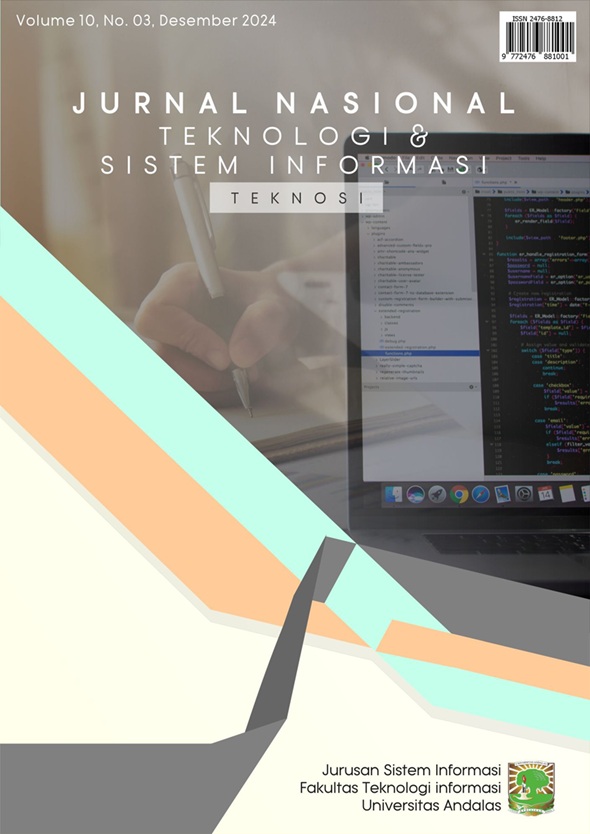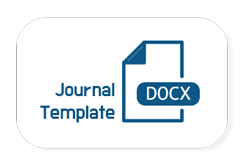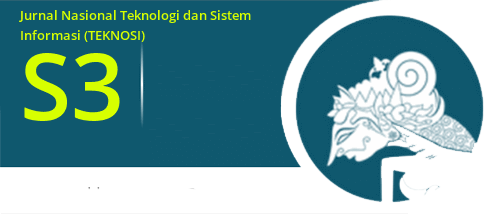Optimasi RoBERTa dengan Hyperparameter Tuning untuk Deteksi Emosi berbasis Teks
DOI:
https://doi.org/10.25077/TEKNOSI.v10i3.2024.240-248Kata Kunci:
Deteksi Emosi, RoBERTa, Hyperparameter Tuning, Teks Bahasa Indonesia, Natural Language ProcessingAbstrak
Deteksi emosi berbasis teks menjadi salah satu topik utama pembahasan dalam pemrosesan bahasa alami. Hal ini dapat disebabkan karena adanya peningkatan jumlah data yang dihasilkan dari interaksi digital, seperti media sosial dan aplikasi pesan instan. Deteksi emosi bertujuan untuk mengenali dan menganalisis respons emosional individu dalam situasi tertentu, dengan penerapan di berbagai bidang seperti interaksi manusia dengan komputer, analisis sentimen, dan layanan kesehatan mental. Penelitian ini bertujuan untuk meningkatkan performa deteksi emosi berbasis teks Bahasa Indonesia menggunakan model RoBERTa. RoBERTa merupakan salah satu varian dari model BERT (Bidirectional Encoder Representations from Transformers) yang telah dioptimalkan untuk pemrosesan bahasa alami dengan mempertimbangkan konteks linguistik secara lebih mendalam. Implementasi RoBERTa dalam deteksi emosi akan dioptimalkan melalui hyperparameter tuning seperti Grid Search, Randomized Search, dan Bayesian Optimization untuk memperoleh kombinasi nilai learning rate, batch size, dan epoch yang optimal, dengan tujuan meningkatkan akurasi dan kemampuan model dalam mendeteksi emosi secara konsisten. Deteksi emosi menggunakana dataset yang terdiri dari 7080 data tweet publik dengan enam kategori emosi, yaitu anger, fear, joy, love, sad, dan neutral. Hasil eksperimen menunjukkan bahwa metode Bayesian Optimization memberikan kombinasi hyperparameter yang optimal dan meningkatkan performa deteksi emosi pada teks berbahasa Indonesia dengan hasil akurasi sebesar 83,64% dan nilai precision, recall dan F1-score secara berutur-turut adalah 83,75%, 83,64%, dan 83,58%.Referensi
W. Anggriyani and M. Fakhriza, “Analisis Sentimen Program Makan Gratis Pada Media Sosial X Menggunakan Metode NLP,†Journal of Computer System and Informatics (JoSYC), vol. 5, no. 4, pp. 1033–1042, 2024, doi: 10.47065/josyc.v5i4.5826.
T. I. Z. M. Putra, S. Suprapto, and A. F. Bukhori, “Model Klasifikasi Berbasis Multiclass Classification dengan Kombinasi Indobert Embedding dan Long Short-Term Memory untuk Tweet Berbahasa Indonesia,†Jurnal Ilmu Siber dan Teknologi Digital, vol. 1, no. 1, pp. 1–28, Nov. 2022, doi: 10.35912/jisted.v1i1.1509.
A. Hamzah and R. Yanwastika Ariyana, “Klasifikasi Emosi Berbasis Emolex dari Komentar Evaluasi Akademik Mahasiswa Emolex-Based Classification of Emotions from Academic Evaluation Comments,†Techno.COM, vol. 23, no. 2, pp. 457–468, May 2024, doi: https://doi.org/10.62411/tc.v23i2.10058.
S. Imron, E. I. Setiawan, and J. Santoso, “Deteksi Aspek Review E-Commerce Menggunakan IndoBERT Embedding dan CNN,†Journal of Intelligent System and Computation, vol. 5, no. 1, pp. 10–16, Apr. 2023, doi: 10.52985/insyst.v5i1.267.
E. Y. Hidayat and D. Handayani, “Penerapan 1D-CNN untuk Analisis Sentimen Ulasan Produk Kosmetik Berdasar Female Daily Review,†Jurnal Nasional Teknologi dan Sistem Informasi, vol. 8, no. 3, pp. 153–163, Jan. 2023, doi: 10.25077/teknosi.v8i3.2022.153-163.
E. Y. Hidayat, R. W. Hardiansyah, and A. Affandy, “Analisis Sentimen Twitter untuk Menilai Opini Terhadap Perusahaan Publik Menggunakan Algoritma Deep Neural Network,†Jurnal Nasional Teknologi dan Sistem Informasi, vol. 7, no. 2, pp. 108–118, Sep. 2021, doi: 10.25077/teknosi.v7i2.2021.108-118.
A. Ansori, “Kepribadian dan Emosi,†Jurnal Literasi Pendidikan Nusantara, vol. 1, no. 1, pp. 41–54, Jun. 2020.
Y. K. Wiciaputra, J. C. Young, and A. Rusli, “Bilingual text classification in english and indonesian via transfer learning using XLM-RoBERTa,†International Journal of Advances in Soft Computing and its Applications, vol. 13, no. 3, pp. 72–87, 2021, doi: 10.15849/ijasca.211128.06.
B. Richardson and A. Wicaksana, “Comparison Of Indobert-Lite And Roberta In Text Mining For Indonesian Language Question Answering Application,†International Journal of Innovative Computing, Information and Control, vol. 18, no. 6, pp. 1719–1734, Dec. 2022, doi: 10.24507/ijicic.18.06.1719.
M. Evtimova, “Hyperparameter Tuning for Address Validation using Optuna,†WSEAS. Transactions on Computer Research, vol. 12, pp. 105–111, Nov. 2023, doi: 10.37394/232018.2024.12.10.
R. Khusuma, W. Maharani, and P. H. Gani, “Personality Detection On Twitter User With RoBERTa,†Jurnal Media Informatika Budidarma, vol. 7, no. 1, p. 542, Feb. 2023, doi: 10.30865/mib.v7i1.5598.
S. Akrah, “DuluthNLP at SemEval-2021 Task 7: Fine-Tuning RoBERTa Model for Humor Detection and Offense Rating,†in Proceedings of the 15th International Workshop on Semantic Evaluation (SemEval-2021), Aug. 2021, pp. 1196–1203.
A. C. N. Simanjuntak et al., “Studi dan Analisis Hyperparameter Tuning IndoBERT Dalam Pendeteksian Berita Palsu,†Jurnal Nasional Teknik Elektro Dan Teknologi Informasi, vol. 13, no. 1, pp. 60–67, 2024, doi: 10.22146/jnteti.v13i1.8532.
D. A. Anggoro and S. S. Mukti, “Performance Comparison of Grid Search and Random Search Methods for Hyperparameter Tuning in Extreme Gradient Boosting Algorithm to Predict Chronic Kidney Failure,†International Journal of Intelligent Engineering and Systems, vol. 14, no. 6, pp. 198–207, Dec. 2021, doi: 10.22266/ijies2021.1231.19.
I. S. Kervanci, M. F. Akay, and E. Özceylan, “Bitcoin Price Prediction Using Lstm, Gru And Hybrid Lstm-Gru With Bayesian Optimization, Random Search, And Grid Search For The Next Days,†Journal of Industrial and Management Optimization, vol. 20, no. 2, pp. 570–588, Feb. 2024, doi: 10.3934/jimo.2023091.
S. Prabu, B. Thiyaneswaran, M. Sujatha, C. Nalini, and S. Rajkumar, “Grid Search for Predicting Coronary Heart Disease by Tuning Hyper-Parameters,†Computer Systems Science and Engineering, vol. 43, no. 2, pp. 737–749, 2022, doi: 10.32604/csse.2022.022739.
Riccosan, K. E. Saputra, G. D. Pratama, and A. Chowanda, “Emotion dataset from Indonesian public opinion,†Data Brief, vol. 43, no. 108465, pp. 1–6, Jul. 2022.
V. Çetin and O. Yıldız, “A comprehensive review on data preprocessing techniques in data analysis,†Pamukkale University Journal of Engineering Sciences, vol. 28, no. 2, pp. 299–312, 2022, doi: 10.5505/pajes.2021.62687.
M. A. Rosid, A. S. Fitrani, I. R. I. Astutik, N. I. Mulloh, and H. A. Gozali, “Improving Text Preprocessing for Student Complaint Document Classification Using Sastrawi,†in IOP Conference Series: Materials Science and Engineering, Institute of Physics Publishing, Jul. 2020, pp. 1–6. doi: 10.1088/1757-899X/874/1/012017.
M. Ayu and A. Muhendra, “Preprocessing of Slang Words for Sentiment Analysis on Public Perceptions in Twitter,†2023. doi: 10.5772/intechopen.113725.
H. Imaduddin, F. Y. A’la, and Y. S. Nugroho, “Sentiment Analysis in Indonesian Healthcare Applications using IndoBERT Approach,†IJACSA, vol. 14, no. 8, pp. 113–117, 2023.
K. L. Tan, C. P. Lee, K. S. M. Anbananthen, and K. M. Lim, “RoBERTa-LSTM: A Hybrid Model for Sentiment Analysis With Transformer and Recurrent Neural Network,†IEEE Access, vol. 10, pp. 21517–21525, 2022, doi: 10.1109/ACCESS.2022.3152828.
N. Gupta, “A Pre-Trained Vs Fine-Tuning Methodology in Transfer Learning,†Journal of Physics, vol. 1947, no. 1, pp. 1–8, 2021.
H. Wang, L. Zhang, K. Yin, H. Luo, and J. Li, “Landslide identification using machine learning,†Geoscience Frontiers, vol. 12, no. 1, pp. 351–364, 2021, doi: https://doi.org/10.1016/j.gsf.2020.02.012.
S. F. M. Radzi, M. K. A. Karim, M. I. Saripan, M. A. A. Rahman, I. N. C. Isa, and M. J. Ibahim, “Hyperparameter tuning and pipeline optimization via grid search method and tree-based autoML in breast cancer prediction,†J Pers Med, vol. 11, no. 10, Oct. 2021, doi: 10.3390/jpm11100978.
A. R. M. Rom, N. Jamil, and S. Ibrahim, “Multi objective hyperparameter tuning via random search on deep learning models,†Telkomnika, vol. 22, no. 4, pp. 956–968, Aug. 2024.
H. Cho, Y. Kim, E. Lee, D. Choi, Y. Lee, and W. Rhee, “Basic Enhancement Strategies When Using Bayesian Optimization for Hyperparameter Tuning of Deep Neural Networks,†IEEE Access, vol. 8, pp. 52588–52608, 2020, doi: 10.1109/ACCESS.2020.2981072.
U. Khairani, V. Mutiawani, and H. Ahmadian, “Pengaruh Tahapan Preprocessing Terhadap Model Indobert Dan Indobertweet Untuk Mendeteksi Emosi Pada Komentar Akun Berita Instagram,†Jurnal Teknologi Informasi dan Ilmu Komputer, vol. 11, no. 4, pp. 887–894, Aug. 2024, doi: 10.25126/jtiik.1148315.
S. Dharmawan, ) Viny, C. Mawardi, ) Novario, and J. Perdana, “Klasifikasi Ujaran Kebencian Menggunakan Metode FeedForward Neural Network (IndoBERT),†pp. 1–6, 2023.
Wildan Amru Hidayat and V. R. S. Nastiti, “Perbandingan Kinerja Pre-Trained Indobert-Base Dan Indobert-Lite Pada Klasifikasi Sentimen Ulasan Tiktok Tokopedia Seller Center Dengan Model Indobert,†Jurnal Sistem Informasi, vol. 11, no. 2, pp. 13–20, Sep. 2024, doi: 10.30656/jsii.v11i2.9168.
Unduhan
Telah diserahkan
Diterima
Diterbitkan
Cara Mengutip
Terbitan
Bagian
Lisensi
Hak Cipta (c) 2024 Jurnal Nasional Teknologi dan Sistem Informasi

Artikel ini berlisensiCreative Commons Attribution-ShareAlike 4.0 International License.
Hak cipta untuk artikel ini ditransfer ke Jurnal Nasional Teknologi dan Sistem Informasi (TEKNOSI) jika dan ketika artikel diterima untuk publikasi. Yang bertanda tangan di bawah ini dengan ini mentransfer setiap dan semua hak di dalam dan ke kertas termasuk tanpa batasan semua hak cipta untuk TEKNOSI. Yang bertanda tangan di bawah ini dengan ini menyatakan dan menjamin bahwa makalah tersebut asli dan bahwa ia adalah pembuat makalah, kecuali untuk bahan yang secara jelas diidentifikasi sebagai sumber aslinya, dengan pemberitahuan izin dari pemilik hak cipta jika diperlukan. Yang bertanda tangan di bawah ini menyatakan bahwa ia memiliki kekuatan dan wewenang untuk membuat dan melaksanakan penugasan ini.
Kami menyatakan bahwa:
- Makalah ini belum diterbitkan dalam bentuk yang sama di tempat lain.
- Makalah ini tidak akan dikirimkan di tempat lain untuk publikasi sebelum penerimaan/penolakan oleh Jurnal ini
- Izin hak cipta diperoleh untuk materi yang diterbitkan di tempat lain dan yang memerlukan izin ini untuk reproduksi.
Selanjutnya, Saya/kami dengan ini mentransfer hak publikasi yang tidak terbatas dari makalah yang disebutkan di atas secara keseluruhan kepada TEKNOSI. Transfer hak cipta mencakup hak untuk mereproduksi dan mendistribusikan artikel, termasuk cetak ulang, terjemahan, reproduksi foto, mikroform, bentuk elektronik (offline, online) atau reproduksi lain yang serupa.
Penulis yang sesuai menandatangani dan menerima tanggung jawab untuk merilis materi ini atas nama setiap dan semua penulis bersama. Perjanjian ini harus ditandatangani oleh setidaknya salah satu penulis yang telah memperoleh persetujuan dari rekan penulis jika berlaku. Setelah pengajuan perjanjian ini ditandatangani oleh penulis yang sesuai, perubahan kepengarangan atau dalam urutan penulis yang tercantum tidak akan diterima.
Hak / Syarat dan Ketentuan yang dipertahankan :
- Penulis memiliki semua hak kepemilikan dalam setiap proses, prosedur, atau artikel manufaktur yang dijelaskan dalam Karya ini.
- Penulis dapat mereproduksi atau mengotorisasi orang lain untuk mereproduksi karya ini atau karya turunannya untuk penggunaan pribadi penulis atau untuk penggunaan perusahaan, dengan ketentuan bahwa sumber dan menyatakan hak cipta dimiliki TEKNOSI, salinan tidak digunakan dengan cara apa pun yang menyiratkan pengesahan TEKNOSI atas suatu produk atau layanan dari pihak mana pun, dan salinannya sendiri tidak ditawarkan untuk dijual.
- Meskipun penulis diizinkan untuk menggunakan kembali semua atau sebagian dari karya ini dalam karya lain, ini tidak termasuk mengabulkan permintaan pihak ketiga untuk mencetak ulang, menerbitkan ulang, atau jenis penggunaan ulang lainnya.














